The Puppy Survival Guide
Toilet training - Why can’t we crack it?
Toilet training is definitely one of the activities that you will want to crack as soon as possible, and it’s something many of us struggle with. The advice we give to all of our clients is that your puppy will need to go to the toilet after they Sleep, after they Play, and after they Eat. If you focus on when your puppy is doing these particular activities, and take her out straight afterwards, it will make it much easier than trying to arrange an on-the-hour schedule with her. You can also stack different activities together to use to your advantage - for example, if you put your puppy in their crate straight after they’ve eaten so they can nap for half an hour/an hour - when they come out they will be much more likely to need the toilet.
How often should I feed my new puppy?
Its incredibly common for new dog owners to be advised to feed their dog three times a day - and whilst this is perfectly normal for a newly weaned puppy, very quickly it will work to your serious disadvantage. By 12 weeks, we recommend switching your new puppy to being fed twice a day - once in the morning and once in the early afternoon. This has several advantages, not least of all that it makes your toilet training much easier. If your puppy eats a larger meal in the afternoon, they will be able to go to the toilet a couple of times in the evening, before going to bed around 10pm. Your puppy Is much more likely to sleep through the night if they don’t have to wake up half way through to release their 8pm evening meal!
Another disadvantage to feeding your puppy 3 times a day is that you are more likely to overfeed your puppy as they get older. Most of us start out meticulously weighing portions, then switch to a rough guess - and its common to give your puppy a little more than they need rather than a little less! At three meals a day, alongside the food treats they are getting as part of their training, puppies can end up receiving far more food than is healthy for them. Obesity is a major issue for many dogs, which starts young. Fewer feeding times is a great way of helping to keep your dog healthy!
The final advantage to feeding a puppy 2 times a day is that it is much easier to connect the ritual of feeding to the walk, which honours the natural behaviour of your dog. Adult dogs should always eat after they have been for a walk, so they form a healthy connection between the exercise and work they do when they are out, with the reward of coming home to eat - and normally rest afterwards. This structure makes it easier to prevent issues like separation anxiety, because a tired dog will be happier to stay behind - and ensures a healthy relationship with food moving into adulthood.
Should my puppy be allowed around the House?
In short, no. Just as with crate training, many people think that it is a kindness to allow your puppy free roam of the house - but in reality, you are setting both yourselves and your puppy up to fail. It is kinder, easier to manage, and less stressful for everyone if your puppy is kept in a specific area of the house - and generally within clear eyesight. In our house, the puppies stay in the kitchen or follow us directly to the office until they are toilet trained and have passed both stages of teething!
For nervous dogs in particular (both puppies and adults) - giving a dog access to the entire house actually puts a lot of additional stress and responsibility one your dog when left alone. They see it as a requirement to ensure that all potential entrances and exits are observed - so that they can alert anyone to potential danger. But in most houses this means your dog has to constantly keep moving, because they can never see all of the exits at once.
Our advice is to encourage your puppy to follow you, and stay in the room where you are, as well as being given access to a specific, controlled space where they have the least likelihood of getting into difficulties. Set your puppy up to succeed - don’t let them wonder around doing what they want!
Should I crate train my puppy/is crate training cruel?
One of the main reasons that people are concerned about crate training is because we look at things from a human perspective, rather than that of a dog. The first thing to remember is that naturally, dogs live in dens - small holes underground. So for a dog, being in a small space is a way of feeling more secure. When a dog knows that danger only comes from one direction, with one entrance and exit - it’s much easier to relax than a situation where danger might come from any corner. It’s often a good idea to put a towel or cover over a crate - to honour this natural feeling.
What is cruel is to leave a dog confined with no way of escape for significant and prolonged periods of time. It shouldn’t need saying - but we will say it anyway. Your dog should always have access to a place to go to the toilet, as well as clean fresh water, and food at the appropriate times - outside of their crate. A crate is a dogs bed and a safe place - it’s an invaluable tool when used properly.
-
Crates are also a very good way of creating a structure for a puppy when it comes to toilet training - because no dog wants to make a mess in their bed. Dog’s will do their best to hold in any toiletry needs - so you can use a crate overnight, or for naps after eating, to provide you with a way of better managing toilet training. This of course comes with responsibility - you need to make sure your puppy is never kept in their crate for longer than they can handle - so be attentive in ensuring that after sleep, the first thing your puppy does is get outside to go to the toilet! Sleeping in and around their own mess is one of the most stressful things a young dog can experience. Don’t worry if accidents happen, but make sure they are cleaned up immediately and fresh bedding is provided.
-
Crate training is also a very useful way of helping your dog to stay out of trouble - by setting them up to succeed. There is no point in leaving your dog in a room full of things that they can chew, damage and destroy If they get frustrated - and then becoming annoyed at your dog because you put them in a situation they couldn’t reasonably handle. When your dog goes in their crate, they should always be very tired and ready to sleep. Invite them into the crate, and help our if needed by introducing their front paws - but always make sure they choose to step in themselves. Wait until they have chosen to relax or sleep before closing the door - and leave when they are calm and relaxed. When you leave, leave calmly without eye contact, touch, or talk. All of these signals act as invites for your puppy to follow you, so leave calmly without excitement. And remember - a dog’s crate is their bed. It should be cosy and comfortable, but shouldn’t have food or water in - any more than you would have your dinner and a a bottle of lemonade in your bed with you! You should never be leaving a dog in a crate for so long that they should be in need of either.
Do’s & Do Not’s for Crate Training
-
Crates are for sleep - not a punishment or a timeout. Help form a healthy association from the beginning.
-
Calmness controls everything, including how your puppy leaves and enters the crate. wait for them to settle before letting them out.
-
Exactly as it says on the tin. Always, immediately and without fail clean up any accidents your puppy may have had.
-
Make sure you have a decent supply of blankets and towels which you can swap out and wash as much as you need to. I also recommend a waterproof mattress, which are tough, easy to clean and more comfortable for your puppy to sleep on.
-
This will just wind your puppy up and stress them out - settle them down 10 minutes before you want to leave, then walk out silently.
-
A crate is a bed for sleeping in and safety - that’s it. Aside from the potential for mess, if your puppy has been left in their crate for long enough that they need food and water, you’re leaving them for too long!
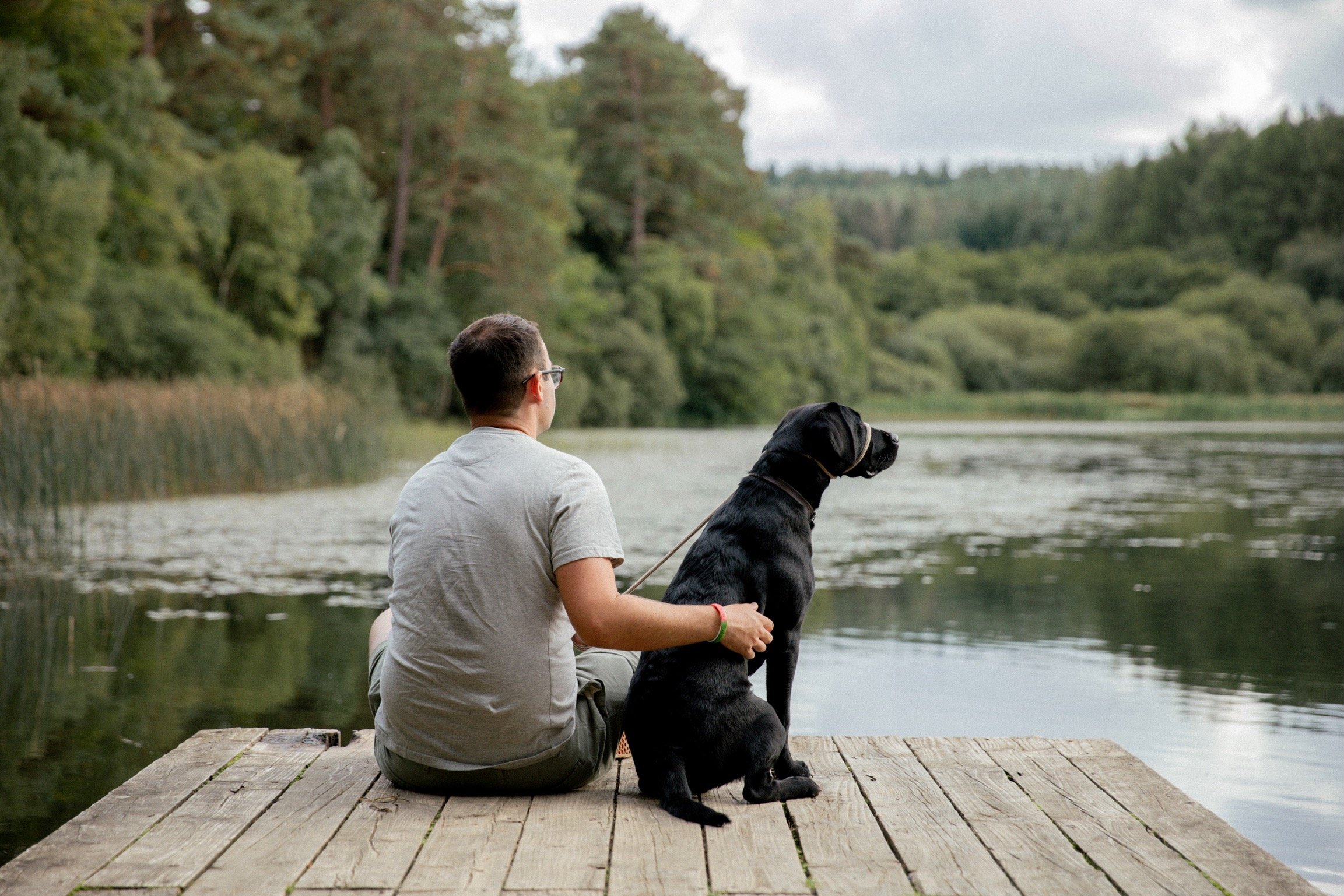
The Dog’s Way Membership
Enjoy exclusive training videos, including our Puppy Diaries - so you can raise your dog just like we do.
Featured Puppy Diaries Videos | Exclusively for Members
Exercise your dog for 5 minutes for every month of their age… and spend the other 23 and a half hours tearing your hair out!
Exercising Puppies
The most important thing when it comes to understand how much exercise is good for your puppy is to first define our terms. If it were the case that by exercise, we are referring specifically to high intensity exercise in the form of sprinting, jumping, and fetching, then there would be some degree of sense in the recommendation. If however, you define exercise as any form of movement - then trying to exercise a 4 month old puppy for 20 minutes a day is nothing short of ridiculous, and can have a massive impact on other behaviours as a result.
What injuries are you trying to prevent?
The most common exercise related injuries in young dogs are torn ligaments, muscle damage and fractures to the bones - which happen as a result of young dogs running too fast for too long, stopping suddenly, or landing heavily. E.g if you have a puppy which is playing fetch - which sprints towards the ball, and either breaks hard to pick it up off the floor, or jumps and lands awkwardly. Puppies and can also develop injuries as a result of accidents in rough play with other dogs (covered further along in this guide) and through environmental hazards such as slipping on ice, or leaping over obstacles in their way.
With this in mind, it should be easy to see that a structured walk on a lead is a far less strenuous form of exercise, in the same way that running through the grass or learning to swim are also far less strenuous on your young puppy.
My exercise Recommendation
10 minutes of intense exercise per month of your dogs age (so an hour for a 6 month old puppy)spread throughout the day, in addition to calm structured walks, or low intensity exploring, swimming, and playing, with no upper limit. Remember that there are 24 hours in a day - so make sure you ask not only how much exercise you are giving your puppy, but how much of their time they are ‘living’, as opposed to ‘waiting on pause’ at home.
The time you spend with your dog is a small part of your life. The Time they spend with you IS their whole life.
Biting, chewing and teething.
“My Puppy keeps biting me!”… “I’m worried our puppy is dominant”… “Our 10 week old puppy attacked our older dog”… “Should I muzzle my puppy?”
This is, understandably, one of our most common queries - and in the vast majority of cases is an overreaction to perfectly normal behaviour. So first things first, don’t worry! You’re definitely not alone in your concerns. Almost all of us who have brought home a puppy have questioned at some point if we have in fact been given a savage beast. Puppy biting is incredibly painful at times, and immensely frustrating - for those with children it can be double stressful. But in almost every case, the conclusions people come to are far from reality, and the steps they take to deal with the ‘problem’ can be immensely damaging to your puppy as as result. So it’s worth getting a clear understanding on what is going on and how to properly deal with these kind of issues.
First things first, A dogs mouth is the equivalent of our hands. And just like with children and adults, puppies have far less dexterity and finesse than adult dogs when it comes to using their mouth. A puppy discovers the world through its mouth, it experiences new things with its mouth. It controls its own space with its mouth and learns to communicate and interact with others using its mouth. Biting as a specific behaviour is a tiny subset of the different things a dog may be doing - and is rarely if ever meant with aggressive intent. Its really important to understand the different ways your puppy can use its mouth and how to deal with these different behaviours.
Diagnose your Puppies Biting
-
The number 1 reason that people get bitten by their puppy is actually because their puppy is teething - which normally presents as a random but relentless attempt for your puppy to get anything into its mouth. If teething is your puppies problem, it should be very easy to direct them onto a chew. We recommend staying natural where possible. Antlers are fantastic, as are some softer dog chews - but you can also use things like Carrot straight from the fridge, wood chews - and things like rope toys. Don’t just shove a carrot in your puppies mouth - use the opportunity to teach. Express disagreement through sound when your puppy is grabbing, and encourage good choices with other objects.
-
The second very common reason your puppy is biting at you (and very often younger children) is because they are bored, which means they aren’t getting enough exercise. By far the hardest time to get through this is between 8 and 12 weeks, when your puppy has come into your home but hasn’t been vaccinated so they aren’t allowed out on walks. You have to be smart here - if you have a high energy puppy, the benefit to your home harmony may be significantly improved by getting your puppy out on a few walks around the neighbourhood. Just avoid other dogs and dirty water! This is also one of the reasons why I suggest picking up your puppy at 9 or 10 weeks. It cuts in half the amount of time your puppy spends stuck with you indoors.
-
Young puppies, like young children, can absolutely get over tired - which means full on toddler tantrums and mania - particularly into the evening. If you want to go into a battle with your puppy at this time, think again. It won’t end well for either of you. The best way you can prevent this scenario from occurring is through a clear structure. That means A consistent daily routine with Fun & Play, Calming Structured Walks, Nap time, feeding and Separation (check out our section on crate training). It also means physical structure. Your puppy is going to relate to different places in the house in terms of the activities they do there. so if you don’t want your puppy going crazy in the lounge, don’t play games with them there! Only let them in when they are ready to sleep.
It is absolutely okay to creat a time-out for these scenarios, and it is best that the timeout is either a safe room like the kitchen, or a small pen separate from their crate. You can alternatively use a small back yard but not a large garden - the idea is space for relaxation and calmness, not a place to punish your dog and isolate them, nor somewhere they can tear around and go wild. They need space to calm down just as much as you do!
-
Whilst there are many reasons why your puppies biting is not aggressive in its intent, there are certainly scenarios where this can be the case - and its incredibly important to understand how to teach through these moments. Dogs which learn to bite people in a genuinely aggressive way do so because they have learned that biting is a highly effective way of getting people to move away and give them space. So its important to stress that if your young puppy is testing different tactics such as growling and grabbing at a young age, the absolute worst thing you can do is back off. I have never met a young puppy less than 3 months old with genuine aggressive intent, But i’ve met a lot of puppies and young dogs who learn by 4 months that its an effective way of getting what they need. Before we dive into the correct way to address this behaviour, its important to understand why your puppy may be trying to create space:
They’re overwhelmed - which means their experience of people is that people never leave them alone. This is particularly common in younger children, but some adults also have a tendency to smother their puppies in an unhealthy way. Lets be absolutely clear - human affection is something you have to teach your puppy to enjoy. Dogs express affection very differently to people. Hugging can be overwhelming and threatening. Hands in your puppies face or the top of their neck can be perceived similarly. Approaching your puppy when they are asleep can make them nervous if they anticipate behaviour they haven’t yet learned to enjoy.
They’re being possessive - which almost always happens in households where puppies are left unsupervised with large amounts of toys, chews, shoes, and other objects - which again most commonly happens when a puppy is given far too much freedom at a young age. This can also be exacerbated with the influx of ‘brain game’ toys that you can stuff with food. Check out our Section on toys and possessions.
They have a specific fear - whilst some dogs are more confident than others, almost any puppy can have a specific fear of something as simple as a brush or a glove, a household item like a broom, clothes board, bin or vacuum cleaner. This fear may cause them to panic and try biting to create space.
We always advise you adopt your puppy at 10 weeks, rather than 8 weeks - when they have had the opportunity to socialise with litter mates and learn to inhibit their biting. It also means you only have to endure two weeks of your puppy being stuck in the house getting frustrated, rather than four. a little patience Absolutely pays off.
Tips to Teach through Biting in Puppies
Now we know why our puppies may want to create space, we need to look at how to teach your puppy not to bite and relax. This is an activity which only adults should be doing, not young children - and an activity where you need to remain calm, gentle and patient. If you are stroking your puppy and they begin to try to grab and bite (which is there way of saying they are uncomfortable) - keep your hand where it is and pause. Express disagreement through sound with a clear, calm sound and wait for your puppy to take their mouth away. I have absolutely no doubt that a puppy grabbing your hand will be painful, but they’re doing it because you’re the one invading their space! You shouldn’t be putting any physical pressure on your puppy whatsoever, your hand simply needs to stay where it is. The moment that they take their mouth away, you give them a nice clear “okay good puppy, well done”, a little stroke, then remove your hand. Your puppy needs to learn that staying calm is how they can ask you to take your hand away, and they will quickly learn that being stroked and massaged feels great!
My top tip for all clients if you have a puppy that is biting in any way that makes you uncomfortable or overwhelmed is to put your puppy on a lead - ideally a simple training slip lead that is easy to get on and off your puppy. The lead allows you to move your puppy away from your personal space, guide them off places you don’t want them to be in a calm manner, and prevent your puppy from forming an excited, frustrated or uncomfortable relationship with being touched. It’s also a lot less painful for you!
The way I teach all my clients is to provide Disagreement through sound, a direction in the form of distance, and a calm outcome, in that you wait for your puppy to sit calmly before releasing the lead tension for them to go as they please. Repeat as necessary so your puppy learns that every time they jump, grab and mouth, they will be moved away and sent to a calmer state of mind. Closeness requires calmness!
It is best to teach in this way when your puppy is relatively calm, rather than waiting until when things are at their absolute worst before expecting your puppy to make sensible decisions. It is also worth saying that this is an exercise which is much easier and only really relevant for young puppies, not for getting into conflict with adult dogs.
Do’s & Do Not’s for Puppies that Bite
-
Your puppy is relying on you to be a good parent. If it was a child kicking screaming and crying, it would need the same parental energy. So stay calm, teach through the moment.
-
Your Puppy knows how you feel and it can escalate their own intensity if you aren’t in control of your emotions. Not a good exercise after a long day at the office!
-
Never back away from a young dog - the worst thing you can do is empower them to be aggressive at a young age. Hold your ground and wait for them to make better choices which you can encourage.
-
A puppy is just that - a puppy. It’s an animal that has barely found its feet on this earth and is still very much a baby, toddler and child at the same time. Treat it that way - teeth are sharp but so are a child’s nails. Fear is something you should never bring to a young animal in need of guidance.
-
If you’re lucky enough to have a great relationship with your Boss, you’re in the minority. Most people associate the word Boss with challenge, confrontation, harsh reprimand or a ‘tell over show’ attitude. You don’t want that, and neither does your puppy.
-
Lead by example, through calmness, confidence and direction. Set your puppy up to succeed, reward great decisions, teach through the bad ones. Aim to be a great leader and parent, not a passive best-friend or co-worker.
Proper Socialisation, Play, and Preventing Aggression
We cannot stress enough that at a young age, the likelihood that your puppy is being inherently aggressive is absolutely minimal. We adopt dogs into our family at a key stage in their socialisation, when they are learning to play and communicate with other dogs. Puppies at this time take it in turns to play in more faux-aggressive and submissive states, so all of the puppies in the group have the opportunity to practice these skills in a play environment ready for later in life.
They will play with other puppies, parents, and other dogs within the group - it’s all part of their learning. It’s very common that you might see a young puppy behave in a way that seems very aggressive towards and older dog. Jumping on them, biting, tugging, mouthing, etc. It is the job of these older dogs to correct and manage the behaviours, to teach the puppy how to play and interact in a healthy way. They learn bite inhibition, personal space boundaries, submissive signals and invitation at this time. When you adopt a puppy, you take on this responsibility - which means your puppy is going to want to have the same experiences with you. And it means its your job as a parent to teach and manage proper social behaviour.
-
Many puppy socialisation classes end up more like lord of the Flies, with a mob of young dogs just going after each other without rules boundaries or limitations. A controlled environment with older dogs allows an opportunity for teaching, and will help your puppy understand the limits of play. If you don’t have an older dog who can help with this, then it is incredibly important that you provide those limitations instead.
Some puppies are more insecure than others, and being jumped all over by boisterous and larger dogs can create negative experiences early on. in the same way, young confident dogs with no-one to match their energy and intensity can very quickly develop an ‘inflated sense of self’ - throwing their weight around, challenging other dogs and causing problems. Another reason why it is so beneficial for puppies to be socialised with well balanced adult dogs who can keep them in check.
-
The Rule I teach my clients with socialisation is the 70-30 rule, which means that you should walk past and ignore 70% of the dogs you see. That leaves 30% of the dogs you see to stop and say hello to - dogs which are calm, confident - dogs which are good teachers and already know social etiquette, dogs that won’t necessarily engage in play every time. Whilst this might seem like the complete opposite of what you read elsewhere, the result of dogs which are over-socialised at a young age is everywhere. Young dogs which learn to not only greet, but get very excited around every dog they see end up being the older dogs with no recall, that come running across the field and knocking your puppy over. In some cases, this behaviour becomes so unmanageable that owners have to keep their adolescent dogs on a lead, which builds high levels of frustration and can ultimately become expressed as Aggression.
Rough Play - No, it’s probably NOT okay.
Raising a young dog is not so different in many ways from raising a child - your puppies social behaviour is a result of the Peers and Mentors they have around them, and your ability as a parents to set limits on over excited behaviour, teach manners (through well behaved puppies and older dogs) and make sure that there is give and take in social interaction. One of my biggest frustrations is when I see young dogs being absolutely mobbed, pinned, rolled and flattened by other dogs, whilst the owners stand and watch. It is normally the case that someone says the line “ it’s just rough play”. Unfortunately, the vast majority of the time - that person is an idiot, and sooner or later their dog is going to cause some serious injury.
As a behaviourist, I take social interaction very seriously - because the reality of my work is that most dogs with aggressive and reactive behaviour are the result of poor socialisation. It’s important to understand that whilst some dogs absolutely do engage in high intensity rough play, it is not acceptable behaviour for the majority of social interactions, anymore than it’s okay for the big kids at secondary school to rugby-tackle the new arrivals from Primary school. The same applies for your puppy! Here are my guidelines for what constitutes healthy vs. unhealthy play interaction between dogs:
-
Play behaviours should be matched and reciprocated. Both dogs should take it in turn to chase and be chased - to bow, to roll over, and to rest. If your dog is always running away, or always chasing the other dogs - the activity has escalated away from play for at least one of the dogs involved.
-
The dog that is chasing should not be biting or pinning at the neck from a chase. This is very common in high prey drive dogs, such as terriers and Sighthounds, and is neither a friendly nor healthy behaviour to practice with your own species. Many young puppies that practice this behaviour end up ‘flicking the switch’ to aggression when their excitement and intensity levels become too high. Hunting your own species is a big no no.
-
When two dogs are not size/weight matched - the larger dog should never be physically knocking the small dog off balance, or rolling them over. Dog’s are generally very aware of their size and strength, and can absolutely regulate play intensity and physicality depending on who they are playing with, just like many dogs do when interacting with children as opposed to adults. However, if a dog is throwing its weight around or consistently knocking your dog off balance, it’s not practicing healthy social behaviour. This is a very common problem with dogs that have only been socialised with other puppies rather than larger adult dogs.
-
Any dog should be allowed to rest. If one of the dogs is dropping to the floor, flashing its teeth, or alternatively is rolling straight over onto its back, that dog is asking for a break - and its important that the game rests at that point. This is a very common cause of fear based aggression and reactivity, where young dogs learn that they have to escalate to higher forms of aggression in order to create space because the other dogs won’t respond to more subtle signals.
-
The most excited play should be reserved for the dogs that your puppy knows and trusts the most. Your puppy is generally going to have a much higher tolerance level for more intense play with dogs that they know well, which is why having close friends (which play well together!) can be highly beneficial. Dogs that have just met shouldn’t be engaging in the highest intensity of play - they need time to build trust before they engage in these activities.
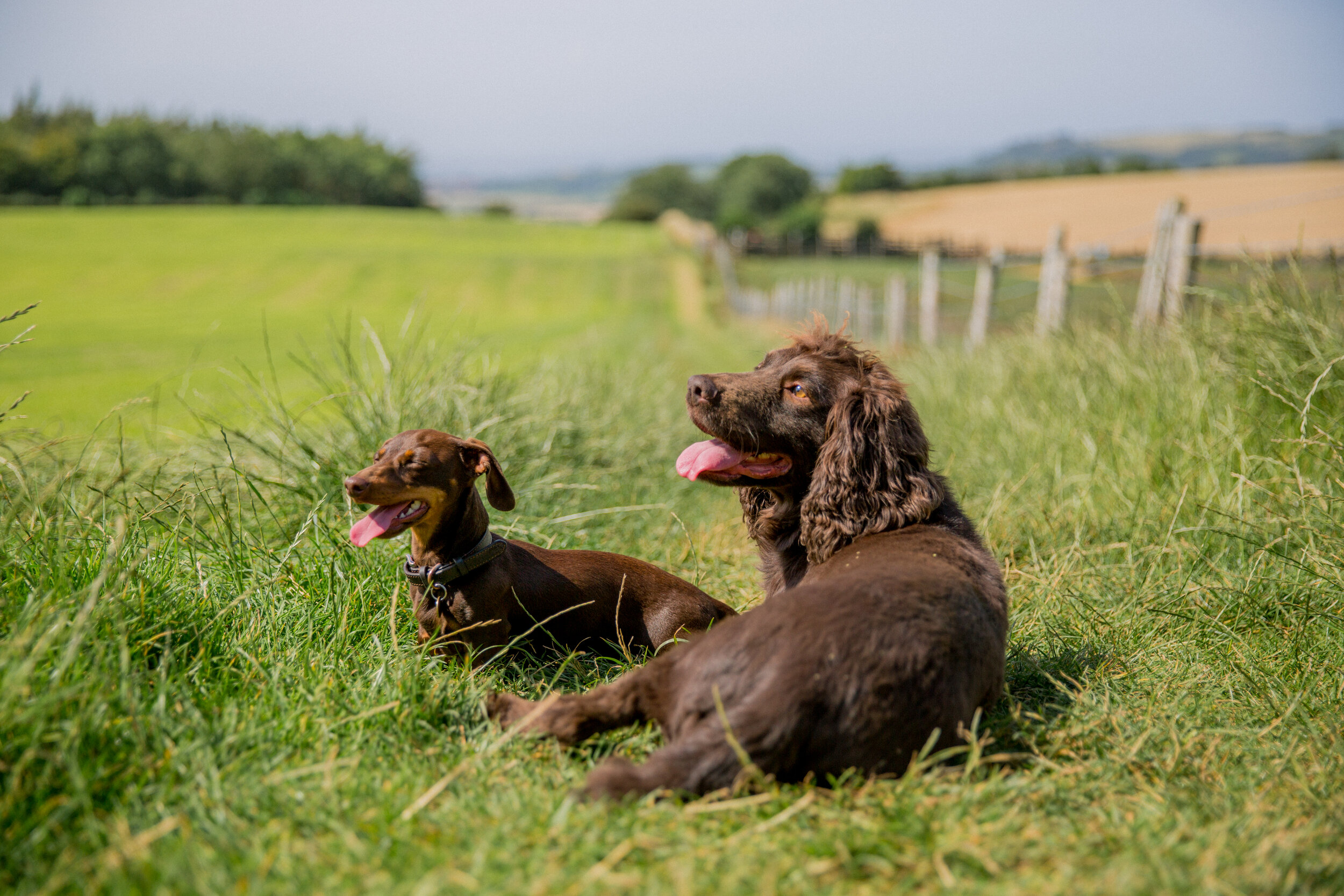
An Example of Healthy, reciprocal Play.
This video demonstrates an example of healthy play where our rules are being observed. Reciprocation, no excessive force, weight matched, rest periods, and play between dogs that know each other well.
How should we introduce our puppy to Children?
Time spent with puppies and children of any age should always be supervised - to ensure that both your puppy and your child are interacting in a way that is beneficial and enjoyable. Dogs are sentient creatures, not toys, and their behaviour is difficult to predict if you aren’t accustomed to dog behaviour and psychology. Play can quickly get out of hand - and children may do things that puppies (and dogs generally) may not be comfortable with. They will act on their instincts if uncomfortable or threatened, which can leave you with an upset child and an unfairly blamed puppy!
The best time to introduce a puppy to a child is when the puppy is tired. They are less likely to want to bite and chew, and more wiling to let a child into their personal space to pet and stroke. It’s also the best time to have a puppy sit on a Childs lap, when they will be most willing to fall asleep. Build a positive relationship by creating experiences like these, so both your puppy and your child learn to interact with each other calmly. If things get too much, make sure you are able to step in. Never leave a child to deal with the situation on their own.
If your puppy is teething, make sure your children understand this - and give them a toy or a chew they can use to keep the puppies teeth away from them. Again - you cannot expect a puppy to stop teething or chewing just because they are playing with a child. set your puppy and your child up to succeed!
In the same way, you need to teach your children how to behave around animals. Which means children need to be calm and quiet, and should always wait for an animal to come to them - not approach a dog on their own. This is an essential skill not just for your young puppy, but for all dogs - and its important that children learn the same skills in both instances. Many accidents happen because children expect all dogs to behave like their dog does at home - which definitely isn’t the case!

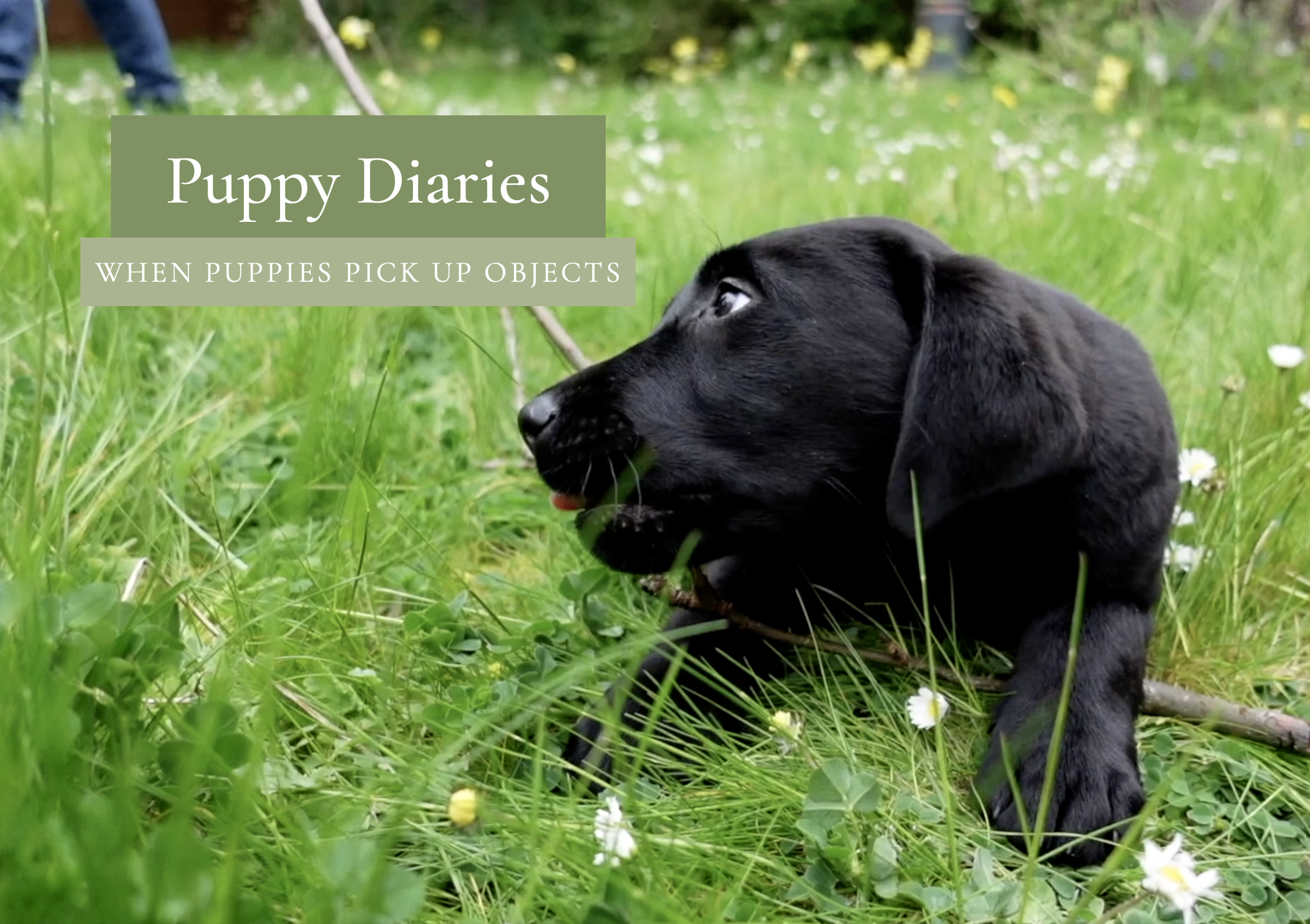

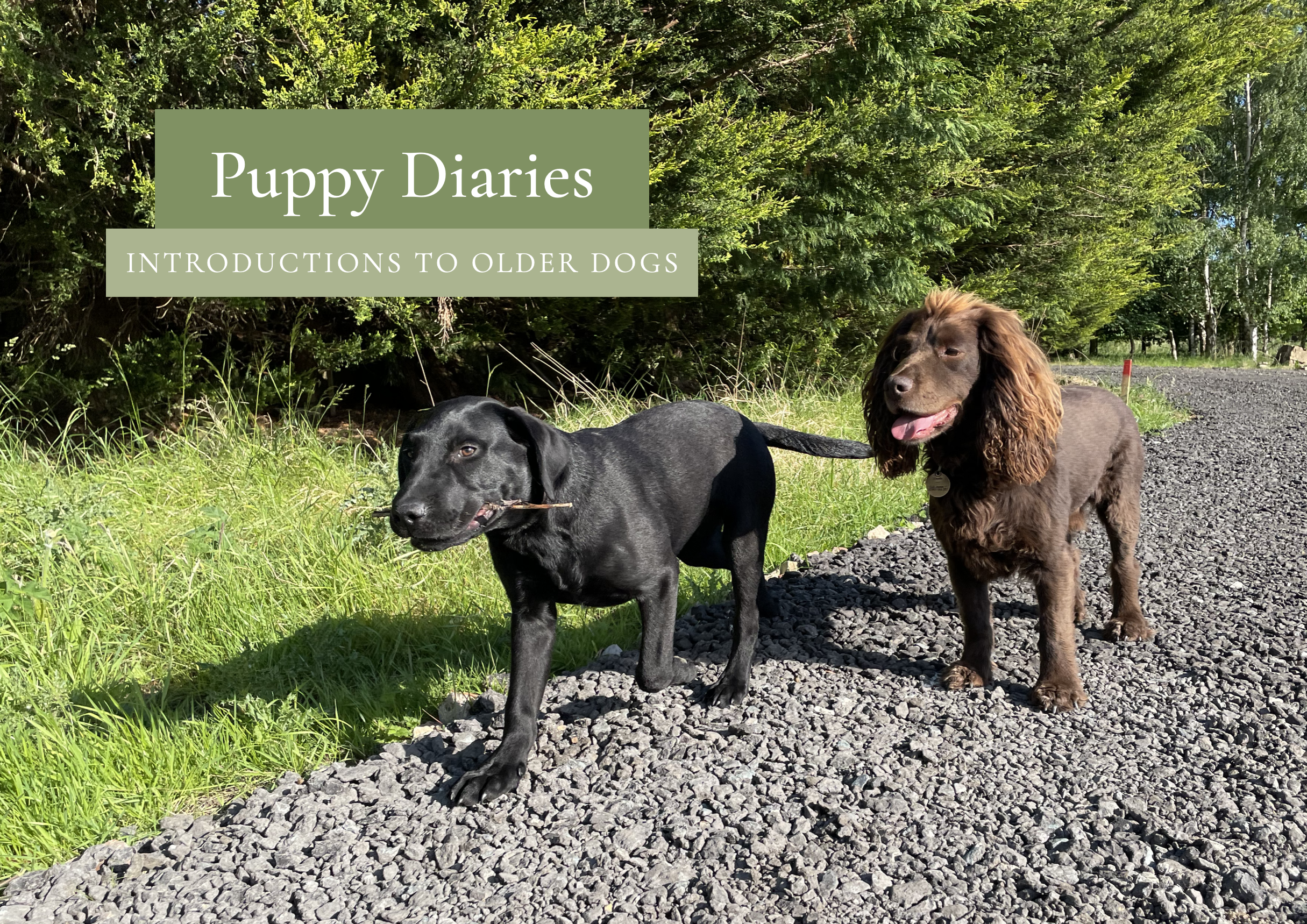

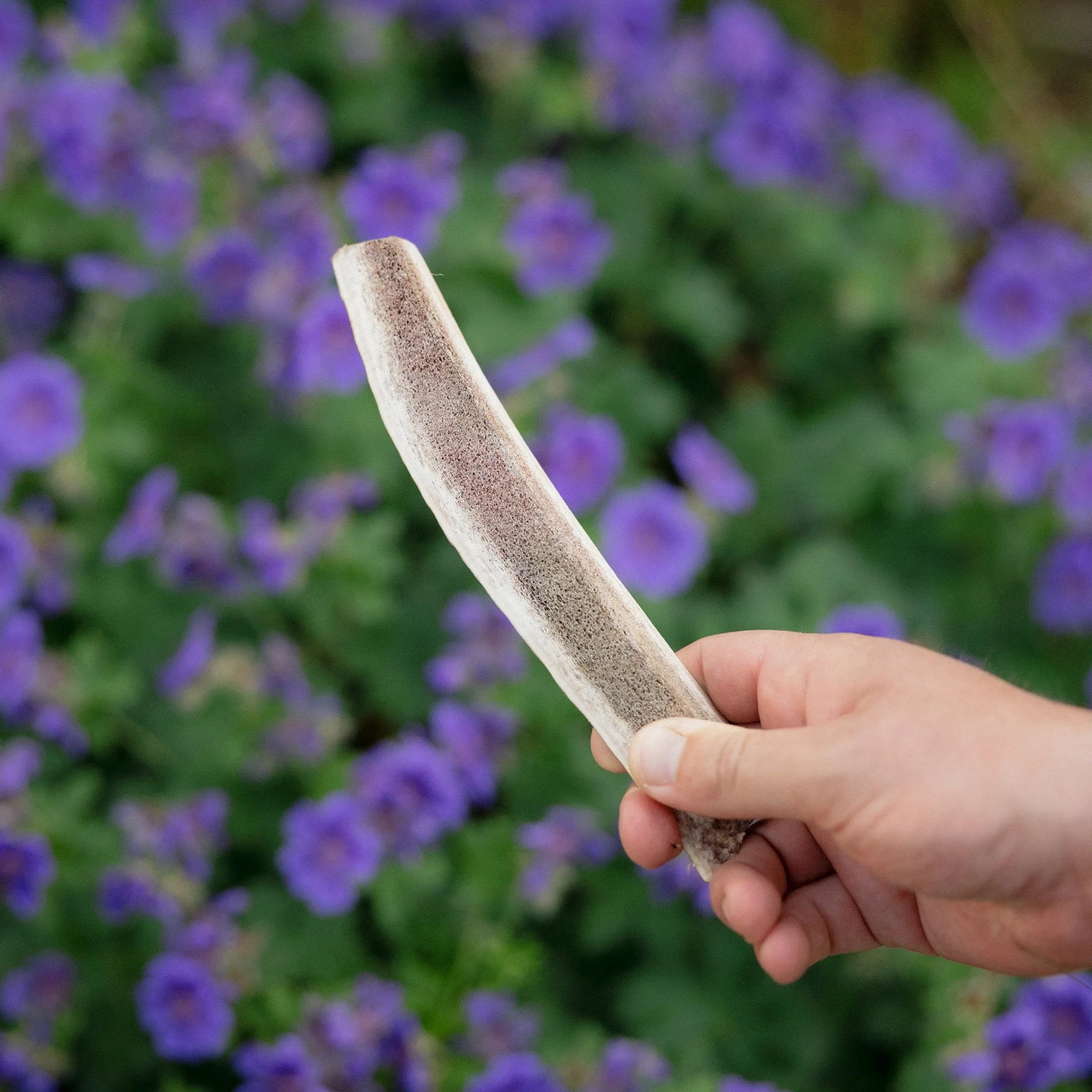
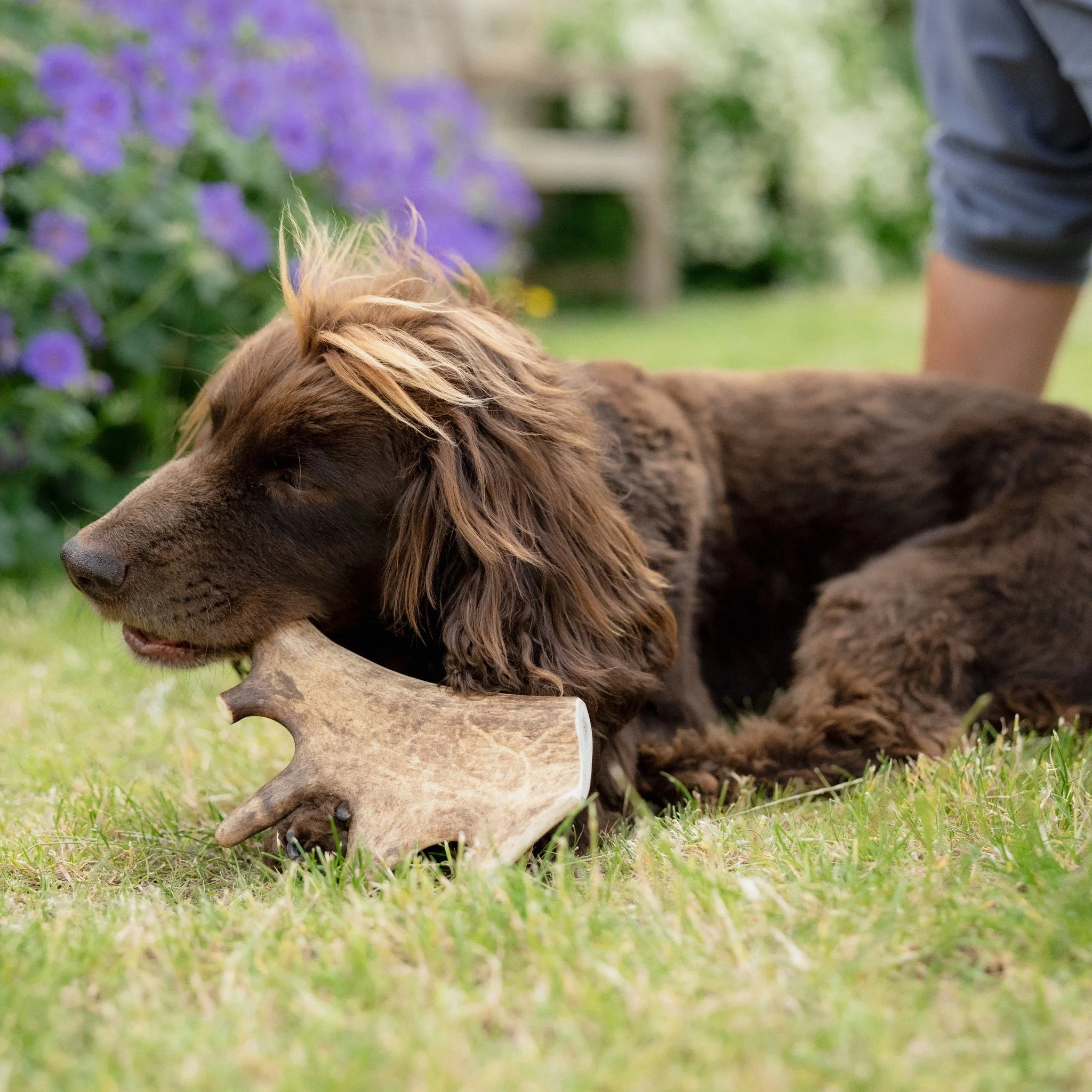

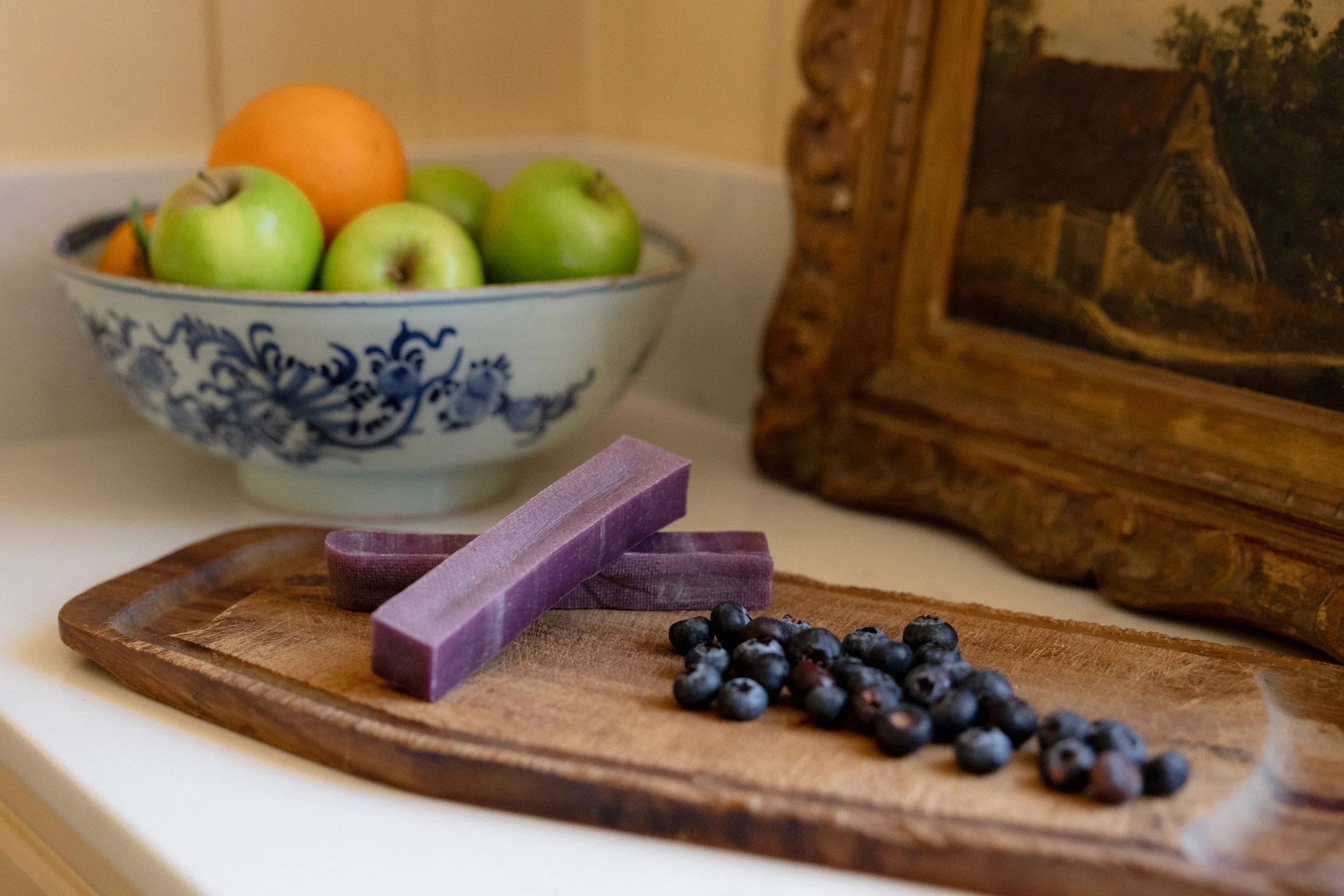
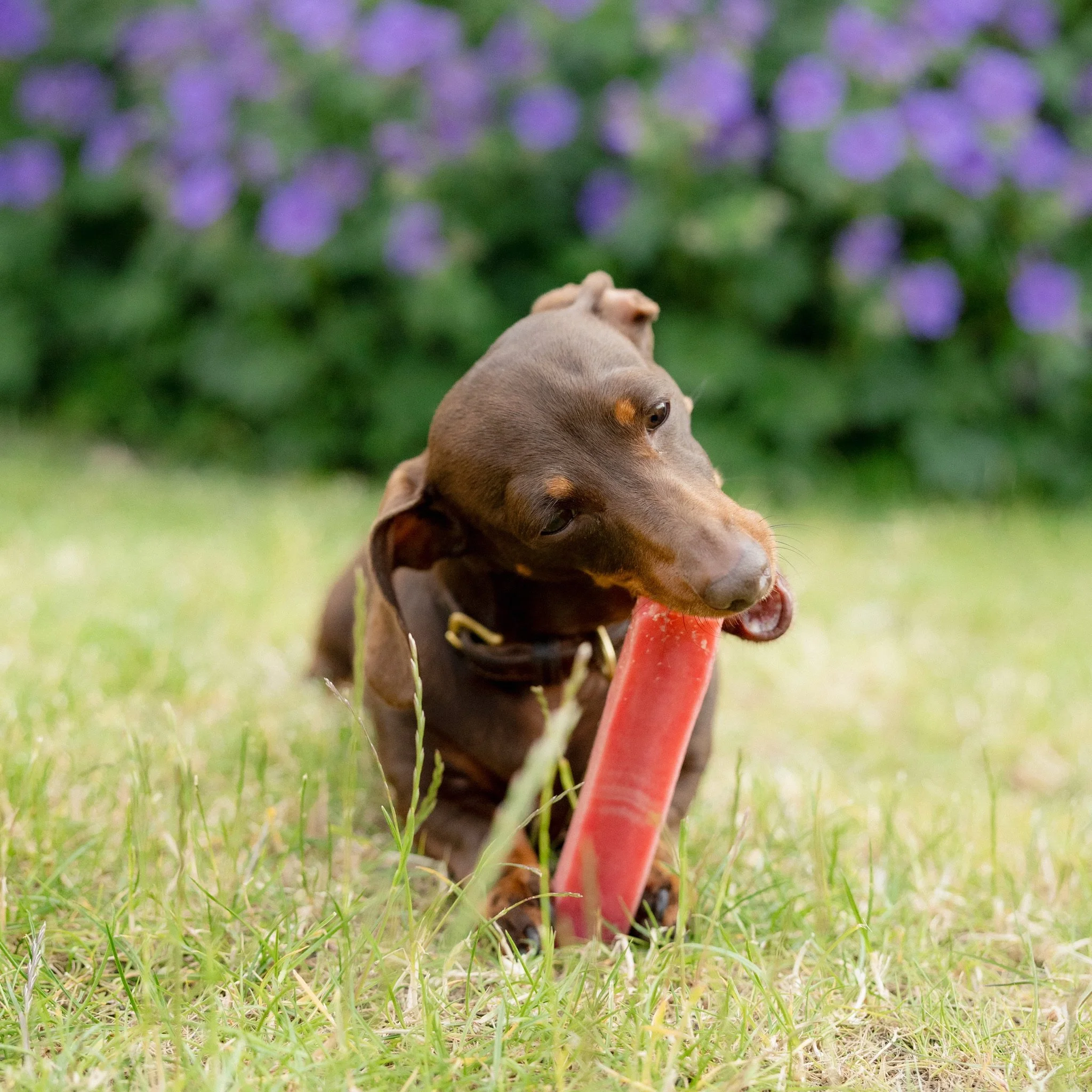
Keeping your dog calm around prey animals and other moving objects like cars, bikes and scooters is something best practiced early and maintained later in life. In this video we explore the activities I practice with Théo to help him relax around birds.
Keeping your dog calm around prey animals and other moving objects like cars, bikes and scooters is something best practiced early and maintained later in life. In this video we explore the activities I practice with Théo to help him relax around birds.